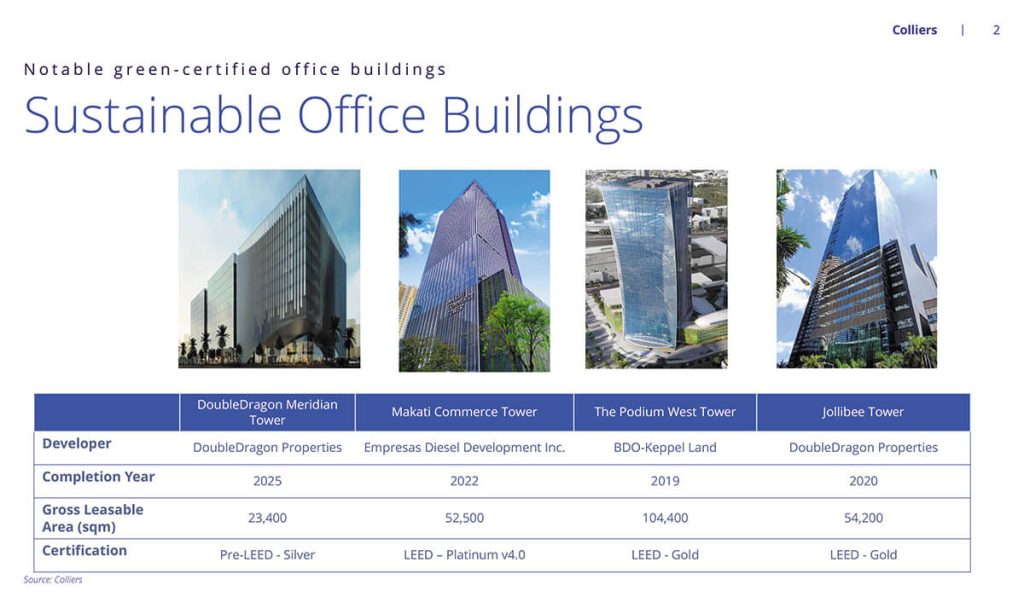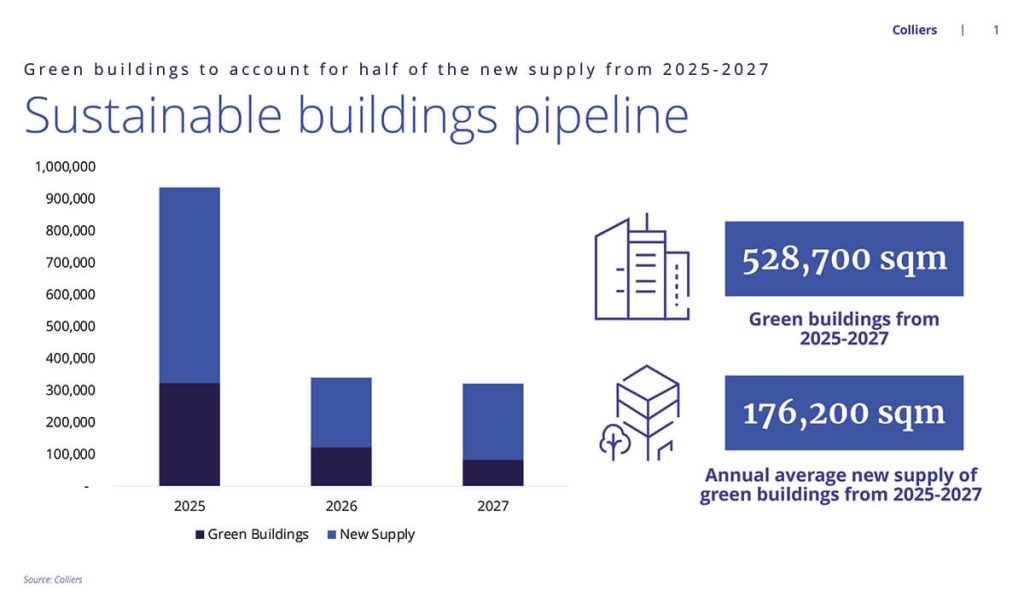The post-pandemic era highlighted the significance of a healthy working environment and of prioritizing the well-being of employees. Sustainability becomes a key requirement for tenants nowadays as they begin to account the importance of providing a workplace conducive to the wellness of its people. Focusing on the direct correlation of sustainable working conditions to employee productivity, organizations start to take up strategies and initiatives that not only promotes environmental gains but also leads to reduction on operational costs.
With these strategies and increasing demand for sustainable buildings, developers are starting to explore green building certifications and adopt practices instrumental to environmental conservation. Being the trusted stewards of the properties under our care, for property management firms like Colliers, it is beneficial to be able to be on top of the green initiatives. Accountability is one of our top commitments for the buildings that we handle, and it is our responsibility to ensure that our strategies are aligned with the developers’ vision as well as the tenants’ requirements.

By adopting green and sustainable practices, the value of a property is notably increased making it more appealing to tenants especially those who have percentage goals on carbon footprint reduction. Furthermore, while sustainable buildings can demand higher rates, there will be a significant amount of savings in the long run as they have low operating costs. The sense of obligation of the respective property managers in support of the sustainability objectives not only benefits the developer by increasing the property value, or the cost savings for tenants; but also positively impacts the environment as a whole.
One example of these initiatives is the equipment used at the Platinum Tower, located in Paranaque City. As part of the building’s waste management practices, the management began to utilize the Food Waste Disposer. This technology works by accelerating the decomposition of food waste, efficiently converting food waste into liquid through microbial degradation. The process only takes twenty (20) hours and produces liquid that is safe to be disposed in the sewage system (all parameters passed, within the prescribed limits, on comprehensive wastewater analysis test). Aside from reduced volume of waste and odor generation that attracts pests, it also decreases the production of methane – a potent greenhouse gas typically associated with slow organic decomposition in landfills. The benefit of utilising this technology aligns with Platinum Tower’s sustainable efforts, as well as its savings on operational costs.

Other buildings with sustainable certifications include The Finance Centre (Daiichi Properties), The Podium West Tower, Sunlife Centre (Sunlife of Canada), Mandani Bay Suites (Cebu), and Makati Commerce Tower.
Sustainable Buildings in the Philippines
The Philippines, an archipelago prone to typhoons, rising temperatures, and urbanization challenges, is increasingly turning to sustainable building practices to address environmental and economic concerns. One of the most widely recognized sustainability frameworks is the Leadership in Energy and Environmental Design (LEED) certification, which promotes eco-friendly construction, efficient energy use, and healthier indoor environments. In this article, we explore the process of creating sustainable buildings in the Philippines and the benefits of LEED-certified structures.
Sustainable buildings, particularly LEED-certified structures in Luzon with emphasis in Metro Manila and Cebu, are revolutionizing the construction industry in the Philippines. By focusing on energy efficiency, resource conservation, and environmental responsibility, these buildings offer economic, health, and environmental benefits. As urbanization continues, the adoption of green building practices will be crucial in creating a more sustainable and climate-resilient Philippines.
Healthy office buildings dominate pipeline
Colliers Philippines believes that building and occupying sustainable and healthy office towers will be the norm moving forward. From 2025 to 2027, Colliers sees the completion of about 1.1 million sq metres of new office space, with about half having green and healthy building certifications such as LEED, WELL, BERDE, etc. This indicates that office developers continue to capture demand from multinational corporations and large Filipino firms that are highlighting the benefits of being in healthy office towers.
For the three-year period, we are expecting the completion of the SM North EDSA Towers 3-5, The Yuchengco Centre, Innoland Altaire, GBF Center 2, DD Meridian Tower and the Vertis North Corporate Center Tower 4 in Metro Manila. Outside of the capital region, office towers likely to be online during the period with sustainable features include Masters Tower Cebu, Two Enterprise in Iloilo, Upper East BPO No. 5 in Bacolod as well as the Pasudeco and Four and Five West Aeropark Towers in Pampanga.
Colliers believes that by investing in sustainable development today, the Philippines can pave the way for a greener, healthier, and more cost-efficient future.
After all, green is in and sustainability is every Filipino’s responsibility.
For feedback, please email joey.bondoc@colliers.com
#PropertyReportFeature
#FeaturedStory
